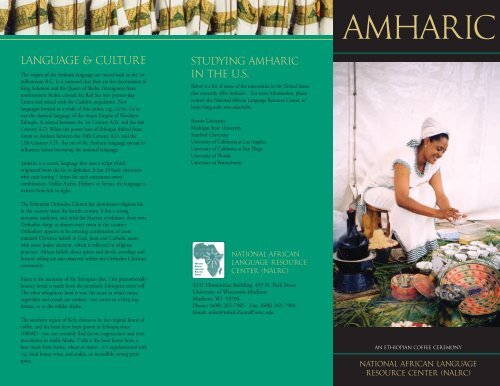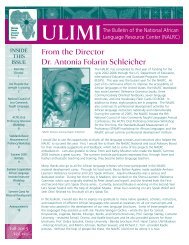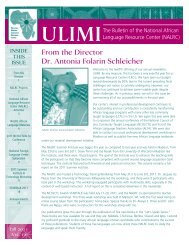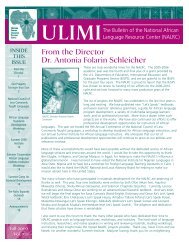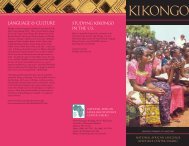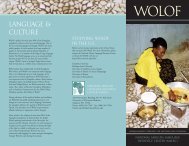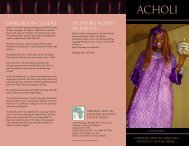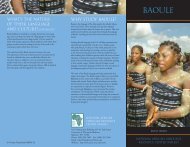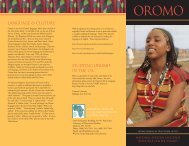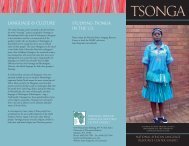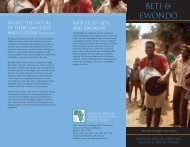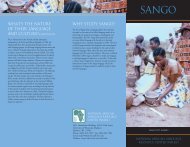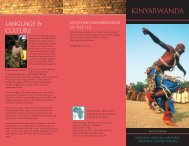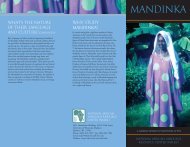AMHARIC - National African Language Resource Center
AMHARIC - National African Language Resource Center
AMHARIC - National African Language Resource Center
Create successful ePaper yourself
Turn your PDF publications into a flip-book with our unique Google optimized e-Paper software.
<strong>AMHARIC</strong><br />
<strong>Language</strong> & Culture<br />
The origins of the Amharic language are traced back to the 1st<br />
millennium B.C. It is rumored that they are the descendants of<br />
King Solomon and the Queen of Sheba. Immigrants from<br />
southwestern Arabia crossed the Red Sea into present-day<br />
Eritrea and mixed with the Cushitic population. New<br />
languages formed as a result of this union, e.g., Ge'ez. Ge'ez<br />
was the classical language of the Axum Empire of Northern<br />
Ethiopia. It existed between the 1st Century A.D. and the 6th<br />
Century A.D. When the power base of Ethiopia shifted from<br />
Axum to Amhara between the 10th Century A.D. and the<br />
12th Century A.D., the use of the Amharic language spread its<br />
influence, hence becoming the national language.<br />
Amharic is a semtic language that uses a script which<br />
originated from the Ge'ez alphabet. It has 33 basic characters<br />
with each having 7 forms for each consonant-vowel<br />
combination. Unlike Arabic, Hebrew or Syrian, the language is<br />
written from left to right.<br />
The Ethiopian Orthodox Church has dominated religious life<br />
in the country since the fourth century. It has a strong<br />
monastic tradition, and until the Marxist revolution, there were<br />
Orthodox clergy in almost every town in the country.<br />
Orthodoxy appears to be amazing combination of more<br />
standard Christian beliefs in God, Jesus and Catholic saints<br />
with some Judaic element, which is reflected in religious<br />
practices. <strong>African</strong> beliefs about spirits and devils, astrology and<br />
fortune telling are also observed within the Orthodox Christian<br />
community .<br />
Injera is the mainstay of the Ethiopian diet. This phenomenally<br />
bouncy bread is made from the peculiarly Ethiopian cereal teff.<br />
The other ubiquitous food is wat, the sauce in which meat,<br />
vegetables and cereals are cooked - wat comes in a fiery, kay<br />
format, or as the milder alicha.<br />
The southern region of Kefa claims to be the original home of<br />
coffee, and the bean have been grown in Ethiopia since<br />
1000AD - you can certainly find decent cappuccinos and even<br />
macchiatos in Addis Ababa. T'ella is the local home brew, a<br />
beer made from barley, wheat or maize - it's supplemented with<br />
t'ej, local honey wine, and arakie, an incredibly strong grain<br />
spirit.<br />
Studying amharic<br />
in the U.S.<br />
Below is a list of some of the universities in the United States<br />
that currently offer Amharic. For more information, please<br />
contact the <strong>National</strong> <strong>African</strong> <strong>Language</strong> <strong>Resource</strong> <strong>Center</strong>, or<br />
http://lang.nalrc.wisc.edu/nalrc.<br />
Boston University<br />
Michigan State University<br />
Stanford University<br />
University of California at Los Angeles<br />
University of California at San Diego<br />
University of Florida<br />
University of Pennsylvania<br />
<strong>National</strong> <strong>African</strong><br />
<strong>Language</strong> <strong>Resource</strong><br />
<strong>Center</strong> (NALRC)<br />
4231 Humanities Building, 455 N. Park Street<br />
University of Wisconsin-Madison<br />
Madison, WI 53706<br />
Phone: (608) 265-7905 Fax: (608) 265-7904<br />
Email: nalrc@mhub.facstaff.wisc.edu<br />
an ethiopian coffee ceremony<br />
<strong>National</strong> <strong>African</strong> <strong>Language</strong><br />
<strong>Resource</strong> <strong>Center</strong> (NALRC)
Why Study <strong>AMHARIC</strong><br />
Amharic is one of the major languages in Ethiopia. It is<br />
spoken by more than 17 million people, about one third of<br />
Ethiopia's population. It has been the language of the court<br />
and the dominant population group in Highland Ethiopia<br />
since at least the late 13th century and remains the official<br />
language of Ethiopia today. As the national language,<br />
Amharic is spoken in every province, including the Amhara<br />
region. Amharic is one of the rare languages in Africa with its<br />
own writing system, a semi-syllabic system called "fidel.”<br />
Amharic is also one of the most widely studied languages in<br />
Ethiopia. It is a field of study at the B.A. and M.A. level and<br />
in the school curriculum it is taught as a subject in most<br />
elementary and secondary levels of education. In the capital<br />
of Ethiopia, Addis Ababa, and in most major towns, it is the<br />
medium of instruction for primary level education. Because<br />
of its past and present role, Amharic has served as a medium<br />
of study of Ethiopian culture and society. Knowledge of the<br />
Amharic language is essential to understanding Ethiopian<br />
culture.<br />
Amharic is very useful to scholars in anthropology, history,<br />
and archaeology as well as in linguistics, since Ethiopia is a<br />
land of great history and treasures. The discovery of Lucy, the<br />
three-million-year-old skeleton, or "dink'nesh" in Amharic<br />
("You are wonderful"), in what is now the Afar area in eastern<br />
Ethiopia, was a momentous event in the history of Ethiopia,<br />
and world archaeology.<br />
Ethiopia provides a rich resource to geologists and biologists.<br />
Massive erosion over the years on the Ethiopian Plateau has<br />
created Simien <strong>National</strong> Park, one of the most spectacular<br />
landscapes in the world. With jagged mountain peaks, deep<br />
valleys and sharp precipices dropping some 1,500 m., this<br />
area is home to many rare animals such as the Geleda<br />
Baboon, the Simien Fox and the Walia Ibex, a goat found<br />
nowhere else in the world.<br />
Others can also benefit from learning Amharic. International<br />
non-profit groups such as The Red Cross, Peace Corps, SIDA<br />
and IFESH as well as United States diplomats and advisors<br />
continuously work in Ethiopia and require language training<br />
in Amharic.<br />
Who Speaks <strong>AMHARIC</strong><br />
People and History<br />
Ethiopians have a record of their rulers that stretches back 3000<br />
- 5000 years. In fact, you can find Biblical passages which<br />
record Ethiopian episodes around 1000 BC. The son of the<br />
Queen of Sheba, Menelik I, is regarded as the first emperor of<br />
Ethiopia - his dynasty ended with Haile Selassie I, who ruled<br />
from 1930 until 1974.<br />
In the first three centuries A.D., Semitic-speaking people built a<br />
"South Arabian" (or "North Ethiopian") type of civilization in<br />
Eritrea, later centering about Aksum in Tigrai Province. As early<br />
as the middle of the fourth century, military expeditions may<br />
have reached the area later known as Amhara. By the mid-ninth<br />
century, a distinctive Amhara region was recognized. The<br />
conquering Semitic-speakers spoke a language which was<br />
perhaps only four to seven centuries removed from a common<br />
origin with Ge'ez, the classical language of the Aksum Empire<br />
and of Medieval Ethiopian religious literature. Meanwhile an<br />
interesting process was taking place among the subjugated<br />
peoples. The military forces were drawn from a number of<br />
diverse ethnic groups: perhaps largely Agew, but with significant<br />
numbers of speakers of other Cushitic and Omotic languages –<br />
they may have had Nilo-Saharan-speaking servants, slaves, and<br />
artisans. A language based on "Cushomotic" syntax (i.e., verbfinal)<br />
and Semitic lexicon was being used for communication in<br />
the ranks and among many of the peasants of Amhara region.<br />
The Amhara are not a cohesive group, politically or otherwise.<br />
Many Amhara in the core area of Gonder, Gojjam, and western<br />
Wello believe that the Amhara of Shewa (who constituted the<br />
basic ruling group under Menelik II and Emperor Haile<br />
Selassie) are not true descendants of the northern Amhara, the<br />
Tigray and heirs to the ancient kingdom of Aksum. Unlike the<br />
Oromo, who constitute Ethiopia’s second largest linguistic<br />
category, the Amhara maintain a nearly homogenous religion<br />
and mode of livelihood. Regional variation aside, the Amhara<br />
are mostly Ethiopian Orthodox Christians and they generally<br />
live in the highlands as plow agriculturalists.<br />
Amharic dancers.<br />
Riding in “tonkwa,” a boat made of papyrus.<br />
Ethiopian Orthodox Ceremony.


